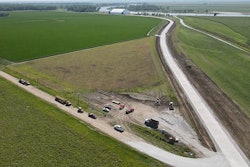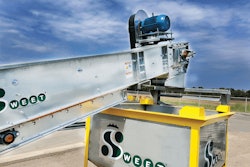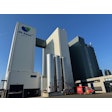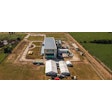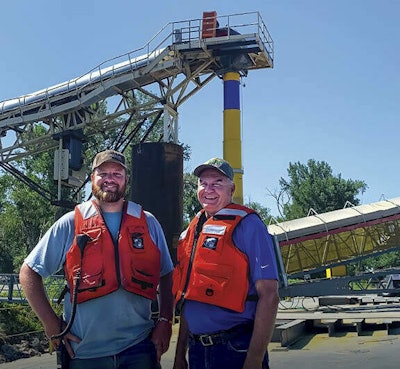
It has been more than 15 years since the grain barge industry in Sioux City, IA, collapsed under the harsh economic burdens of the early 2000s farm economy.
For 15 years, producers, grain elevators and co-ops in the area had to rely on more expensive and inefficient methods of transporting grain to other markets.
That 15-year drought has finally been doused with the opening of NEW Cooperative’s port in Blencoe, IA.
Using a combination of farmer grit and ingenuity, the team at NEW Cooperative has reopened the waterways for its members with an $11 million barge port.
Repeating the past
NEW Cooperative was founded in 1973 by two Iowa farmers’ cooperatives that understood they would be stronger working together.
One of the cooperatives had rail capabilities but could not consistently fill outgoing trains, while the other cooperative had the grain needed to fill those trains. They came together, forming NEW Cooperative and were able to supply rail markets with Iowa grain.
It’s fitting that NEW Cooperative was formed in an effort to get Iowa producers access to more markets because almost 50 years later, they are still building with that mission in mind.
When NEW Cooperative saw the opportunity for its farmers to access barge traffic on the Missouri River, its team started to plan.
Like the farmers who started NEW Cooperative, the team behind the Blencoe Port used lateral thinking. Frank Huseman, operations manager for NEW Cooperative, explained the creative and open process.
“It’s been really fun working with the team we put together to build the port,” says Huseman. “We’ve never done anything like this, and the river fluctuations made us think about every process.”
That level of detail and thought can be seen in every aspect of the Port of Blencoe. Nothing was done without purpose.
Rising tides can sink ports
On the surface, the port of Blencoe seems simple. Two affixed belt conveyors bought from a defunct coal mining company, large portable conveyors from THOR Global Enterprises Ltd., an unloading crane and a barge loader also from THOR make up most of the equipment. Looks can be deceiving, though, as every part of the port has been given a monumental amount of thought from the design team.
The need to adjust to the Missouri River’s changing water levels can be seen throughout the design of the port. The river can rise and drop several feet during a standard year. In years with extreme drought or precipitation, the fluctuation can be much more. For example, from January to May 2019, the Midwest was the wettest it has ever been. According to the National Weather Service, at the time of publishing, the Missouri River near Blencoe, IA, is 20.5 feet, a few feet below average. However, on June 1, 2019, the Missouri River crested 30.27 feet just north of Blencoe. The flooding in the Midwest caused hundreds of millions of dollars in property loss that year, and the region is still recovering. The flood of 2019 left its mark on the NEW Cooperative planning team, who took it into account with the final port.
“The goal is to stay as mobile as we can because of potential high water,” explains Huseman. “The elevation of our warehouse is 1,042.5 feet. In 2011, the water got to 1,041 feet. We took this area and raised it, then we put in a three-foot wall around the edge and made sure we can block off the doorways. If the water would get up to the 2011 level or higher, we will still have dry product.”
Almost everything at the Port of Blencoe is movable in case the river floods. Conveyors can be moved into the fertilizer building or onto the port’s loadout area to keep them safe until the high water recedes.
Filling a boat
The water level also forced NEW Cooperative to choose an innovative platform as a place for barges to dock. The co-op bought a large barge, The Pearl River, which was used to transport space shuttle parts for NASA, from a United States auction to serve as a platform that will rise and fall with the river while being able to support the weight of the loadout crane, barge loader and portable conveyors.
The port can dock six barges at a given time, tying them to a series of steel pipes that were driven 50 feet below the mud line of the riverbed and filled with aggregate. Once a tugboat has dropped off barges at the port, it can move on to another location. When a barge is loaded, it is moved away from the loader, and another barge is moved into place with a series of winches.
Eliminating the need to have a tugboat stay with the barges at the port, NEW Cooperative saves the tugboat rental fees, making the port more efficient.
The Pearl River is separated into two halves, an unloading area on the upstream half and loading on the downstream half. Unloading a barge is done with a crane that scoops the product from the barge and drops it onto the 800 ton/hour THOR conveyor then onto the former coal conveyor to be loaded onto a truck or into the fertilizer warehouse. Huseman mentions that locals are excited to bring in additional products, such as gravel and sand.
Filling a barge takes around 50 truckloads of grain from the nearby NEW Cooperative grain elevator. The trucks unload into one of two portable dump pits as crews maneuver the conveying equipment. Grain goes directly from the truck onto the barge, and the employees at the port need to move quickly to keep the port running smoothly.
“The crew here are the ones that do all the work, and they deserve a lot of credit,” says Huseman.
Crews are vigilant as the product is loaded into the barge, moving the spout from hatch to hatch as the barge gets filled.
“We needed to have the ability to move our spout loader, so we could fill every hold of the barge, without having to move the barge itself,” says Huseman. “THOR delivered with a portable conveyor that moves along a half-moon route.
“The route allows the telestacker to be moved so we can hit all of the hatches and fill the whole barge with minimum space taken up on The Pearl River.”
Opening the door to the world
The Port of Blencoe is up and running for NEW Cooperative and its members, but the spirit of improvement and ingenuity is far from over at the facility. Plans for a new road directly from the interstate to the port are already in the works, with grants from the local, state and federal government to help fund it. There is also talk of a few more permanent structures and possibly even onsite commodity storage in the near future.
“We had a very successful open house. It drew in hundreds of members, media, as well as the Iowa governor and secretary of agriculture,” explains Huesman.
“Co-ops are designed to do things farmers can’t do for themselves, and this project fits that well. One person said it was the most exciting thing that’s happened in Blencoe since the circus train got stuck in a blizzard in the ‘80s. We want to show them what a difference this project can make to the economy in western Iowa.” ■
.jpg?auto=format%2Ccompress&crop=faces&fit=crop&h=48&q=70&w=48)


